Inhibition of IFN-gamma-dependent antiviral airway epithelial defense by cigarette smoke
- PMID: 20504369
- PMCID: PMC2890646
- DOI: 10.1186/1465-9921-11-64
Inhibition of IFN-gamma-dependent antiviral airway epithelial defense by cigarette smoke
Abstract
Background: Although individuals exposed to cigarette smoke are more susceptible to respiratory infection, the effects of cigarette smoke on lung defense are incompletely understood. Because airway epithelial cell responses to type II interferon (IFN) are critical in regulation of defense against many respiratory viral infections, we hypothesized that cigarette smoke has inhibitory effects on IFN-gamma-dependent antiviral mechanisms in epithelial cells in the airway.
Methods: Primary human tracheobronchial epithelial cells were first treated with cigarette smoke extract (CSE) followed by exposure to both CSE and IFN-gamma. Epithelial cell cytotoxicity and IFN-gamma-induced signaling, gene expression, and antiviral effects against respiratory syncytial virus (RSV) were tested without and with CSE exposure.
Results: CSE inhibited IFN-gamma-dependent gene expression in airway epithelial cells, and these effects were not due to cell loss or cytotoxicity. CSE markedly inhibited IFN-gamma-induced Stat1 phosphorylation, indicating that CSE altered type II interferon signal transduction and providing a mechanism for CSE effects. A period of CSE exposure combined with an interval of epithelial cell exposure to both CSE and IFN-gamma was required to inhibit IFN-gamma-induced cell signaling. CSE also decreased the inhibitory effect of IFN-gamma on RSV mRNA and protein expression, confirming effects on viral infection. CSE effects on IFN-gamma-induced Stat1 activation, antiviral protein expression, and inhibition of RSV infection were decreased by glutathione augmentation of epithelial cells using N-acetylcysteine or glutathione monoethyl ester, providing one strategy to alter cigarette smoke effects.
Conclusions: The results indicate that CSE inhibits the antiviral effects of IFN-gamma, thereby presenting one explanation for increased susceptibility to respiratory viral infection in individuals exposed to cigarette smoke.
Figures
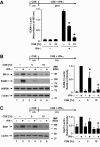

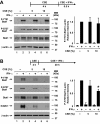

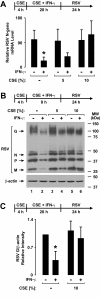
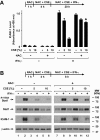
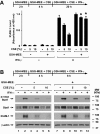


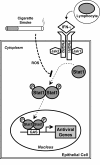
Similar articles
-
Cigarette smoke decreases innate responses of epithelial cells to rhinovirus infection.Am J Respir Cell Mol Biol. 2011 Jan;44(1):118-26. doi: 10.1165/rcmb.2009-0266OC. Epub 2010 Mar 11. Am J Respir Cell Mol Biol. 2011. PMID: 20224072 Free PMC article.
-
Inhibition by cigarette smoke of nuclear factor-κB-dependent response to bacteria in the airway.Am J Respir Cell Mol Biol. 2011 Feb;44(2):155-65. doi: 10.1165/rcmb.2009-0454OC. Epub 2010 Mar 26. Am J Respir Cell Mol Biol. 2011. PMID: 20348206 Free PMC article.
-
Specific inhibition of type I interferon signal transduction by respiratory syncytial virus.Am J Respir Cell Mol Biol. 2004 Jun;30(6):893-900. doi: 10.1165/rcmb.2003-0410OC. Epub 2004 Jan 12. Am J Respir Cell Mol Biol. 2004. PMID: 14722224
-
Molecular Mechanisms of N-Acetylcysteine in RSV Infections and Air Pollution-Induced Alterations: A Scoping Review.Int J Mol Sci. 2024 May 31;25(11):6051. doi: 10.3390/ijms25116051. Int J Mol Sci. 2024. PMID: 38892239 Free PMC article.
-
RSV Reprograms the CDK9•BRD4 Chromatin Remodeling Complex to Couple Innate Inflammation to Airway Remodeling.Viruses. 2020 Apr 22;12(4):472. doi: 10.3390/v12040472. Viruses. 2020. PMID: 32331282 Free PMC article. Review.
Cited by
-
Lung Organoids in Smoking Research: Current Advances and Future Promises.Biomolecules. 2022 Oct 12;12(10):1463. doi: 10.3390/biom12101463. Biomolecules. 2022. PMID: 36291672 Free PMC article. Review.
-
NOD1 agonist iE-DAP reverses effects of cigarette smoke extract on NOD1 signal pathway in human oral mucosal epithelial cells.Int J Clin Exp Med. 2015 Aug 15;8(8):12519-28. eCollection 2015. Int J Clin Exp Med. 2015. PMID: 26550162 Free PMC article.
-
Cytokines and Regulating Epithelial Cell Division.Curr Drug Targets. 2024;25(3):190-200. doi: 10.2174/0113894501279979240101051345. Curr Drug Targets. 2024. PMID: 38213162 Review.
-
Host, technical, and environmental factors affecting QuantiFERON-TB Gold In-Tube performance in children below 5 years of age.Sci Rep. 2022 Nov 19;12(1):19908. doi: 10.1038/s41598-022-24433-w. Sci Rep. 2022. PMID: 36402803 Free PMC article.
-
Lactobacillus rhamnosus Restores Antiviral Signaling and Attenuates Cytokines Secretion from Human Bronchial Epithelial Cells Exposed to Cigarette Smoke and Infected with SARS-CoV-2.Probiotics Antimicrob Proteins. 2023 Dec;15(6):1513-1528. doi: 10.1007/s12602-022-09998-2. Epub 2022 Nov 8. Probiotics Antimicrob Proteins. 2023. PMID: 36346611 Free PMC article.
References
-
- Bradley JP, Bacharier LB, Bonfiglio J, Schechtman KB, Strunk R, Storch G, Castro M. Severity of respiratory syncytial virus bronchiolitis is affected by cigarette smoke exposure and atopy. Pediatrics. 2005;115:e7–e14. - PubMed
-
- U.S. Department of Health and Human Services. The health consequences of involuntary exposure to tobacco smoke: a report of the Surgeon General. Department of Health and Human Services, Centers for Disease Control and Prevention, Coordinating Center for Health Promotion, National Center for Chronic Disease Prevention and Health Promotion, Office on Smoking and Health, Atlanta, GA; 2006.
-
- Blake GH, Abell TD, Stanley WG. Cigarette smoking and upper respiratory infection among recruits in basic combat training. Ann Intern Med. 1988;109:198–202. - PubMed
Publication types
MeSH terms
Substances
Grants and funding
LinkOut - more resources
Full Text Sources
Medical
Molecular Biology Databases
Research Materials
Miscellaneous

